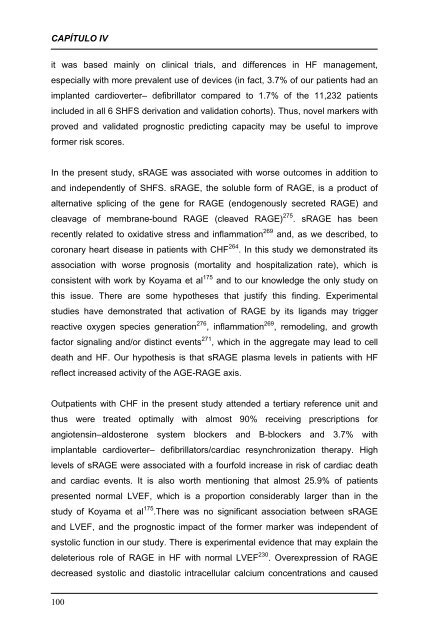INTRODUCCIÓN: REVISIÓN CRITICA DEL PROBLEMA
INTRODUCCIÓN: REVISIÓN CRITICA DEL PROBLEMA
INTRODUCCIÓN: REVISIÓN CRITICA DEL PROBLEMA
Create successful ePaper yourself
Turn your PDF publications into a flip-book with our unique Google optimized e-Paper software.
CAPÍTULO IV<br />
it was based mainly on clinical trials, and differences in HF management,<br />
especially with more prevalent use of devices (in fact, 3.7% of our patients had an<br />
implanted cardioverter– defibrillator compared to 1.7% of the 11,232 patients<br />
included in all 6 SHFS derivation and validation cohorts). Thus, novel markers with<br />
proved and validated prognostic predicting capacity may be useful to improve<br />
former risk scores.<br />
In the present study, sRAGE was associated with worse outcomes in addition to<br />
and independently of SHFS. sRAGE, the soluble form of RAGE, is a product of<br />
alternative splicing of the gene for RAGE (endogenously secreted RAGE) and<br />
cleavage of membrane-bound RAGE (cleaved RAGE) 275 . sRAGE has been<br />
recently related to oxidative stress and inflammation 269 and, as we described, to<br />
coronary heart disease in patients with CHF 264 . In this study we demonstrated its<br />
association with worse prognosis (mortality and hospitalization rate), which is<br />
consistent with work by Koyama et al 175 and to our knowledge the only study on<br />
this issue. There are some hypotheses that justify this finding. Experimental<br />
studies have demonstrated that activation of RAGE by its ligands may trigger<br />
reactive oxygen species generation 276 , inflammation 269 , remodeling, and growth<br />
factor signaling and/or distinct events 271 , which in the aggregate may lead to cell<br />
death and HF. Our hypothesis is that sRAGE plasma levels in patients with HF<br />
reflect increased activity of the AGE-RAGE axis.<br />
Outpatients with CHF in the present study attended a tertiary reference unit and<br />
thus were treated optimally with almost 90% receiving prescriptions for<br />
angiotensin–aldosterone system blockers and B-blockers and 3.7% with<br />
implantable cardioverter– defibrillators/cardiac resynchronization therapy. High<br />
levels of sRAGE were associated with a fourfold increase in risk of cardiac death<br />
and cardiac events. It is also worth mentioning that almost 25.9% of patients<br />
presented normal LVEF, which is a proportion considerably larger than in the<br />
study of Koyama et al 175 .There was no significant association between sRAGE<br />
and LVEF, and the prognostic impact of the former marker was independent of<br />
systolic function in our study. There is experimental evidence that may explain the<br />
deleterious role of RAGE in HF with normal LVEF 230 . Overexpression of RAGE<br />
decreased systolic and diastolic intracellular calcium concentrations and caused<br />
100
















